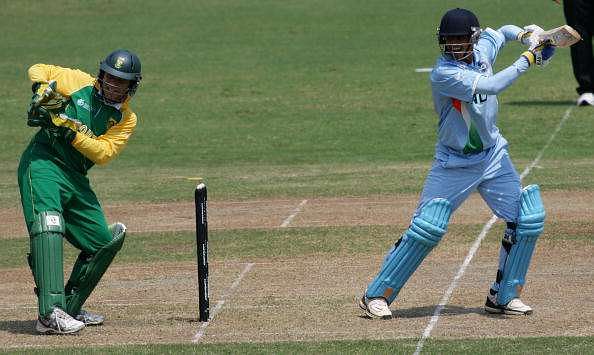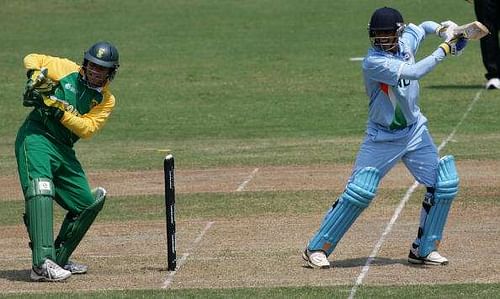
The unrecognised magician that Taruwar Kohli is

Starry eyes, sheepish smiles. Slender frames, puberty hit faces. Charming innocence, a life of dreams a heartbeat away.
There’s something very gratifying in watching under 19 cricket. It’s hard to really put a finger on what it actually is. It could arouse within us one emotion, or many at the same time.
It could be anything, but it is definitely something. And no matter how different this something is to different people, it definitely strikes a chord. In the softest of spots, even in otherwise steel covered hearts.
For some, it could be a reminder of their teenage years, when even becoming the President of the United States didn’t seem too tough to their childishly optimistic selves. For others, it could be about watching sport in its actual essence, in all its splendid glory. A perfect cocktail with equal amounts fun and equal amounts competition, something which the senior level is not.
Also read: The docile yet effective Test opener
For me, and I’m sure there are many others like me, it’s something else.
For me, the joy I derive from watching under 19 cricket is the feel-good factor of kids trying to make a name for themselves. Out there, exposed in front of the whole world. On television, in the heavily competitive world of professional sport.
We relate to them because unlike most senior level cricketers, they don’t strike you as immortals, as beings having unattainable geniuses. They are not trained to manage their behaviour by public relations agencies. They are not told to keep their emotions in check or to have politically correct opinions. They are not burdened by sport, by the demi-God status people have imposed on their seniors.
They, unlike senior professionals, are themselves. And it’s in the highs and lows of these cricket playing humans, with their yet inconsistent facial hair growth and teenage awkwardness that we form an inseparable bond.
A bond which makes us follow their entire cricketing journey with the same enthusiasm we had when we first saw them playing a square drive, or bowling a wrong ‘un. A bond which makes us keep a constant tab on their scores, leading to a disappointed ‘tchch’ sound when they fail, and a loud yelp combined with a clenched fist when they perform well.
The 2008 under 19 World Cup was when I first developed a cricketing bond like this. With a top order batsman who went by the last name, Kohli.
On Friday, February 22, 2008, the under 19 World Cup is in full swing in Kuala Lumpur, Malaysia. India, one of the top teams in the tournament, are playing the West Indies.
On a sluggish wicket, India lose the toss and are put into bat. Kohli is opening, with two successive fifties behind him. This match carries significance, his role does too.
If there is one word to describe his stance, it would probably be serene. It’s an unlikely way to describe something which is essentially a bodily posture, but that’s what it was. A gentle bend of the knees, head resting right on top of the left shoulder. Bat standing firmly at waist height, not dangling here and there. Lips pursed, eyes focussed yet nonchalant.
But the stance was not the only aesthetically pleasing sight about his batting. His bat swing, his foot movement and his follow through were all laden with grace. His batting was unbelievably beguiling. Even the usually drab leaves. The movements so languid, you would probably think he was an artist using his bat as his brush to paint the canvas that was the Kinrara Oval cricket ground.
Kohli’s batting was arresting, it was decorous to the extent that it numbed you, even overwhelmed you, you felt so many emotions all in a second and a half. Had John Keats seen him bat, his “Thing of beauty” would have probably been about the serenading art that was Kohli’s batting.
Stylish as his batting was, it didn’t translate into quick runs. He left a lot, and defended a lot. Looking at the scoreboard, one couldn’t be faulted for thinking that he was struggling. That it was all a big graft, that the going was tough.
Also read: ICC Under-19 2008 World Cup winning Indian Squad: Where are they now?
Except, that it wasn’t. It was just how he batted. Calm, collected, unhurried. It was straight from the age gone by, and probably a misfit in the current times. The well-judged leaves weren’t appreciated anymore, the outside edge for four was. The elegantly solid front foot defence was jeered, the bludgeoning slog over cow corner applauded.
Kohli was a magician, just in a time people were busy dealing with the many challenges of reality. Cricket, as an art, and batting specifically, was changing. It was evolving, compromising grace for action and here Kohli found himself out of place.
He was a Roman Holiday in the age of Fast & Furious, the Gregory Peck to your Dwayne ‘The Rock’ Johnson, the Beatles to your Eminem, the lazy winter afternoon to the chaotic summer night. Kohli was the monochrome of yesteryear to the colour of today, and yet he shone brighter. And was more vivid.
Born a decade or two earlier, and he may have been a star too.
Back in the game against the West Indies, Kohli plays another characteristically unhurried, assured innings. His 54 off 84 balls lays the platform for the others to go straight into the attacking mode, with India reaching a total of 265 by the end.
Kohli hits just four boundaries, but the shots were all there. It’s just that he found the fielders each time. He wasn’t one for taking the aerial route, and this is probably the aspect which prevented him from scoring freely.
Much like his other innings, the bowlers didn’t get him out. A bid to force the pace did. He was caught at cover, trying to hit one over the circle.
There wasn’t much of a celebration. For he wasn’t seen as the big gun, the one who could win matches off his own bat, the one who could alter the course of destiny. Just like his batting, just like his demeanour, things around Kohli were quiet. There was no hype, no expectations.
The cricketing world was just too blind to notice magic.
As of today, Kohli has just played 27 first class matches, with a mediocre average of 32. It seems strange then that I’m portraying him as having the potential of becoming a great of the game.
What people will not notice, or will not want to notice is that his dismissals have come in trying to play the sort of cricket which modern day coaches and captains want to play, that which requires quick scoring.

While it’s impossible to see how he’s been dismissed in all his innings, a large majority of them have been because of trying to accelerate.
It’s like expecting the Imagine Dragons to sing heavy metal or expecting Metallica to compose lullabies.
It may sound as an excuse, but it’s not. Had Kohli been allowed to play the way he does, or if he was born in a different time, I strongly believe he would have made one hell of a Test cricketer. And a mighty elegant one at that.
People would look at an average of 32 and shrug him off. But Kohli is not about averages. Kohli is something to be experienced, his batting, a sight as captivating as the Taj Mahal against the most perfect of sunsets.
But that’s not how the world sees it.
It makes me think that they aren’t wrong when they say that ‘progress’ hasn’t been the greatest gift to humanity. A bit exaggerated, I know. But, still. It captures the emotions.
On February 22, 2008 another Kohli, Virat, the captain of that team, the big gun with all the hype made a 74 ball 100, at a strike rate of 135, more than double of that of the Kohli who opened.
He is the quintessential modern-day cricketer, the Indian Test captain and arguably the best player in the world
The Kohli who opened makes sporadic appearances for Punjab in the Ranji Trophy now. For the world, he’ll always be the other Kohli from the 2008 batch, the one who didn’t make it. For me, Taruwar Kohli will always be the one who stood out.
Virat may have been a better batsman, but Taruwar was the one who struck a chord. Virat was great, but Taruwar was magic.